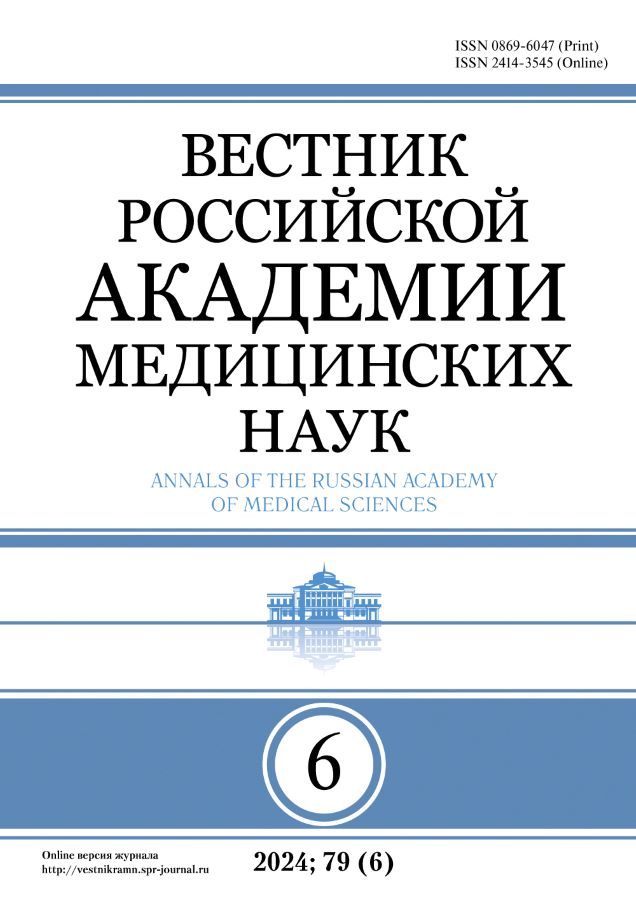Том 67, № 9 (2012)
- Год: 2012
- Дата публикации: 10.09.2012
- Статей: 10
- URL: https://vestnikramn.spr-journal.ru/jour/issue/view/22
- DOI: https://doi.org/10.15690/vramn679
МАТЕРИАЛЫ СЕССИИ РАМН
МЕХАНИЗМЫ ПОРАЖЕНИЯ ГОЛОВНОГО МОЗГА ПРИ ВИЧ-ИНФЕКЦИИ
Аннотация
Рассмотрены механизмы транспорта вируса иммунодефицита человека (ВИЧ) через гематоэнцефалический барьер, сосудистые сплетения и взаимодействие его с клетками мозга, имеющих CD4-рецепторы и корецепторы ССR-5 и CXCR-4. Отмечен острый и латентный периоды в формировании мозговых нарушений, обозначенных в клинике различными терминами («ВИЧ-энцефалопатия», «ВИЧ-ассоциированные нейрокогнитивные нарушения» и др.). В повреждении мозга участвуют различные химические ингредиенты от провоспалительных цитокинов до токсичных белков ВИЧ, на что уходит несколько лет до развития ВИЧ-деменции. Уже на ранних этапах выявлены значительные нарушения метаболизма глюкозы, изменения на электроэнцефалограмме (ЭЭГ) с вызванными потенциалами, что может служить маркером ВИЧ-инфекции. Наряду с другими лучевыми и клиническими методами контроля выявлены генетические различия ВИЧ в крови и спинномозговой жидкости (СМЖ) с разной устойчивостью к лекарственным препаратам, что ориентирует на разработку новых подходов к терапии.
 4-12
4-12


ПРИМЕНЕНИЕ ТЕХНОЛОГИЙ ЯДЕРНОЙ МЕДИЦИНЫ В НЕВРОЛОГИИ, ПСИХИАТРИИ И НЕЙРОХИРУРГИИ
Аннотация
В обзоре проведен анализ использования технологий ядерной медицины [позитронной эмиссионной томографии (ПЭТ) и однофотонной эмиссионной компьютерной томографии (ОФЭКТ)] в диагностике, дифференциальной диагностике и оценке эффективности заболеваний центральной нервной системы (ЦНС). На основе собственного опыта и последних данных литературы продемонстрированы возможности методов радионуклидной визуализации при различных вариантах деменции, паркинсонизма, опухолях головного мозга. Проанализированы результаты применения ПЭТ в оценке эффективности стереотаксических вмешательств у пациентов с тревожно-обсессивными расстройствами.
 13-18
13-18


НОВЫЕ ТЕХНОЛОГИИ В ХИРУРГИИ НЕТРАВМАТИЧЕСКИХ ВНУТРИЧЕРЕПНЫХ КРОВОИЗЛИЯНИЙ
Аннотация
Совершенствование методов нейровизуализациии и нейрофизиологии, широкое внедрение методов микрохирургии, нейроэндоскопии, нейронавигации и интраоперационных методов контроля радикальности операций в хирургии нетравматических внутричерепных кровоизлияний, развитие нейроанестезиологии и нейрореанимации открыли новые возможности в лечении аневризм и артериовенозных мальформаций (АВМ) головного мозга и гипертензивных гематом. При своевременной диагностике и правильном выборе методов лечения нетравматических внутричерепных кровоизлияний достигаются хорошие функциональные исходы при минимальной летальности.
 19-26
19-26


ПУТИ РАЗВИТИЯ СОВРЕМЕННОЙ НЕЙРОРЕАНИМАТОЛОГИИ
Аннотация
В обзорной статье дается определение, цели и задачи нейрореаниматологии, краткая история ее формирования. Рассматриваются базисные направления, лежащие в ее основе, — искусственная вентиляция легких (ИВЛ), внутричерепное давление (ВЧД), нейромониторинг. Описываются основные виды патологии и специфические методы, применяемые в нейрореаниматологии. Приводятся результаты собственных исследований по смерти мозга — разработка Национальных критериев; по синдрому Гийена-Барре (СГБ) — уменьшение в 2 раза длительности пребывания на ИВЛ и в 2,5 раза времени восстановления способности к самостоятельной ходьбе; по дифтерийной полинейропатии (ДП) — снижение летальности в 11 раз, по сравнению с общероссийскими показателями; по нетравматическому персистирующему вегетативному состоянию (ПВС) — разработка диагностических и прогностических нейрофизиологических критериев. Описываются результаты по изучению синдрома полиорганной недостаточности (СПОН) при тяжелых инсультах. Обсуждаются перспективы дальнейшего развития нейрореаниматологии.
 27-30
27-30


СОВРЕМЕННЫЕ ТЕХНОЛОГИИ В ХИРУРГИЧЕСКОМ ЛЕЧЕНИИ ПОСЛЕДСТВИЙ ТРАВМЫ ЧЕРЕПА И ГОЛОВНОГО МОЗГА
Аннотация
В сообщении (созданном по материалам доклада, представленного на Сессии общего собрания РАМН, Санкт-Петербург, 14−15 июня 2012 г.) представлены основные хирургически значимые формы посттравматической патологии у 4136 пациентов с дефектами и деформациями костей свода, основания черепа и лицевого скелета, рецидивирующей ликвореей, артериосинусными соустьями, истинными и ложными аневризмами и др. Разработана классификация последствий и осложнений черепно-мозговой травмы, а также периодизация ее клинического течения. Раскрыты возможности современных нейровизуализационных технологий распознавания и исследования патогенеза последствий и осложнений черепно-мозговой травмы. Особое внимание уделено реконструктивной и минимально инвазивной хирургии, детально описан метод компьютерного моделирования и последующего стереолитографического лазерного воспроизведения полномасштабных копий черепа, его дефектов и имплантатов, что особенно значимо при обширных и сложных краниобазальных и краниофациальных повреждениях. Обосновано дифференцированное применение интракраниальных и эндоназальных доступов для закрытия хронических ликворных фистул. Вместе с впервые созданной в НИИ нейрохирургии им. Н.Н. Бурденко методикой эндоваскулярной реконструкции магистральных сосудов с помощью баллонов-катетеров Ф.А. Сербиненко представлены новые подходы, опирающиеся на современные технологии с использованием стентов, микроспиралей и эмболизирующих композиций.
 31-38
31-38


ФУНДАМЕНТАЛЬНЫЕ ОСНОВЫ ПЛАСТИЧНОСТИ НЕРВНОЙ СИСТЕМЫ
Аннотация
Основой пластичности нервной системы является модификация эффективности синаптической передачи: длительная потенциация или депрессия. Применение современных технологий: регистрация ионных токов отдельных клеток, молекулярно-генетический анализ нейровизуализация, компьютерное моделирование и другие методы раскрывают молекулярные механизмы, лежащие в основе синаптической пластичности, что, в свою очередь, открывает перспективы фармакологической коррекции и генной терапии неврологическиих расстройств, связанных с болезнью Альцгеймера, алкоголизмом, гипоксией, старением и различными формами нарушения обучения и памяти.
 39-44
39-44


НЕСТАБИЛЬНОСТЬ ГЕНОМА ГОЛОВНОГО МОЗГА: ЭТИОЛОГИЯ, ПАТОГЕНЕЗ И НОВЫЕ БИОЛОГИЧЕСКИЕ МАРКЕРЫ ПСИХИЧЕСКИХ БОЛЕЗНЕЙ
Аннотация
 45-53
45-53


ХРОНИЧЕСКАЯ БОЛЬ: МЕДИКО-БИОЛОГИЧЕСКИЕ И СОЦИАЛЬНО-ЭКОНОМИЧЕСКИЕ АСПЕКТЫ
Аннотация
 54-58
54-58


СОСТОЯНИЕ МЕДИЦИНСКОЙ НАУКИ
ПРЕДСТАВЛЕННОСТЬ ПУБЛИКАЦИЙ УЧЕНЫХ РАМН В WEB OF SCIENCE: ОЦЕНКА ТЕКУЩИХ ПОКАЗАТЕЛЕЙ И ПЕРСПЕКТИВ ИХ УВЕЛИЧЕНИЯ
Аннотация
Оценен вклад публикаций ученых РАМН в национальный публикационный массив, отраженный в Web of Science за последние 30 лет. Рассчитаны показатели публикационной активности, которые необходимы НИУ РАМН для достижения в краткосрочной перспективе соответствия библиометрическому индикатору, установленному Указом Президента Российской Федерации от 7 мая 2012 г. (увеличение доли российских публикаций в Web of Science до 2,44% к 2015 г.). Показано, что сложившаяся структура глобальной науки, в которой на медицинские публикации приходится около трети публикационного мирового потока, ставит перед учеными РАМН особенно сложную задачу: удвоить за три года количество публикаций, индексируемых в Web of Science. Рассматриваются первоочередные и необходимые меры для выполнения этой задачи.
 59-64
59-64


НАУЧНО-ПРАКТИЧЕСКИЕ И ОБРАЗОВАТЕЛЬНЫЕ АСПЕКТЫ КЛИНИЧЕСКОЙ ЭПИДЕМИОЛОГИИ
Аннотация
Даны определение, цель и задачи клинической эпидемиологии. Показано, что клиническая эпидемиология является разделом эпидемиологии, который позволяет разрабатывать стандарты диагностики, лечения и профилактики, основанные на доказательствах, и подбирать соответствующий алгоритм действий для каждого конкретного клинического случая. Всесторонне рассмотрены взаимоотношения клинической эпидемиологии и доказательной медицины. Обосновано положение о том, что эпидемиологические исследования являются методической основой клинической эпидемиологии и доказательной медицины. «Золотым стандартом» получения доказательной информации являются рандомизированные контролируемые исследования. Представлены исторические этапы формирования клинической эпидемиологии. Показано, что развитие клинической эпидемиологии и расширение преподавания этого раздела будут способствовать прогрессу медицинской науки и практики здравоохранения.
 65-69
65-69













